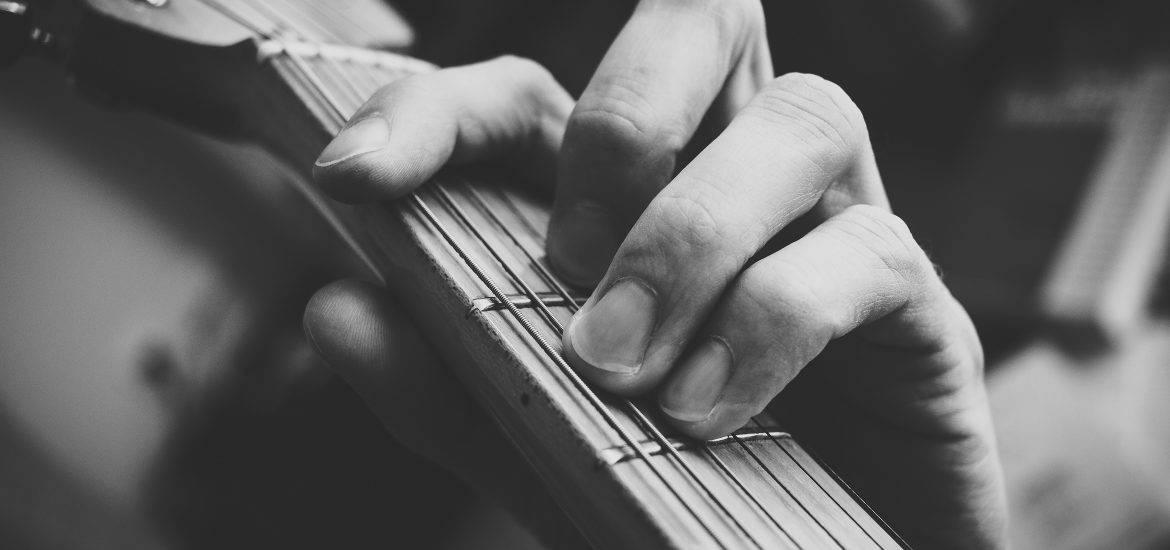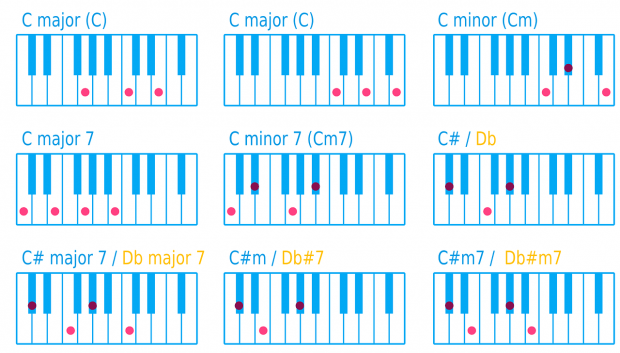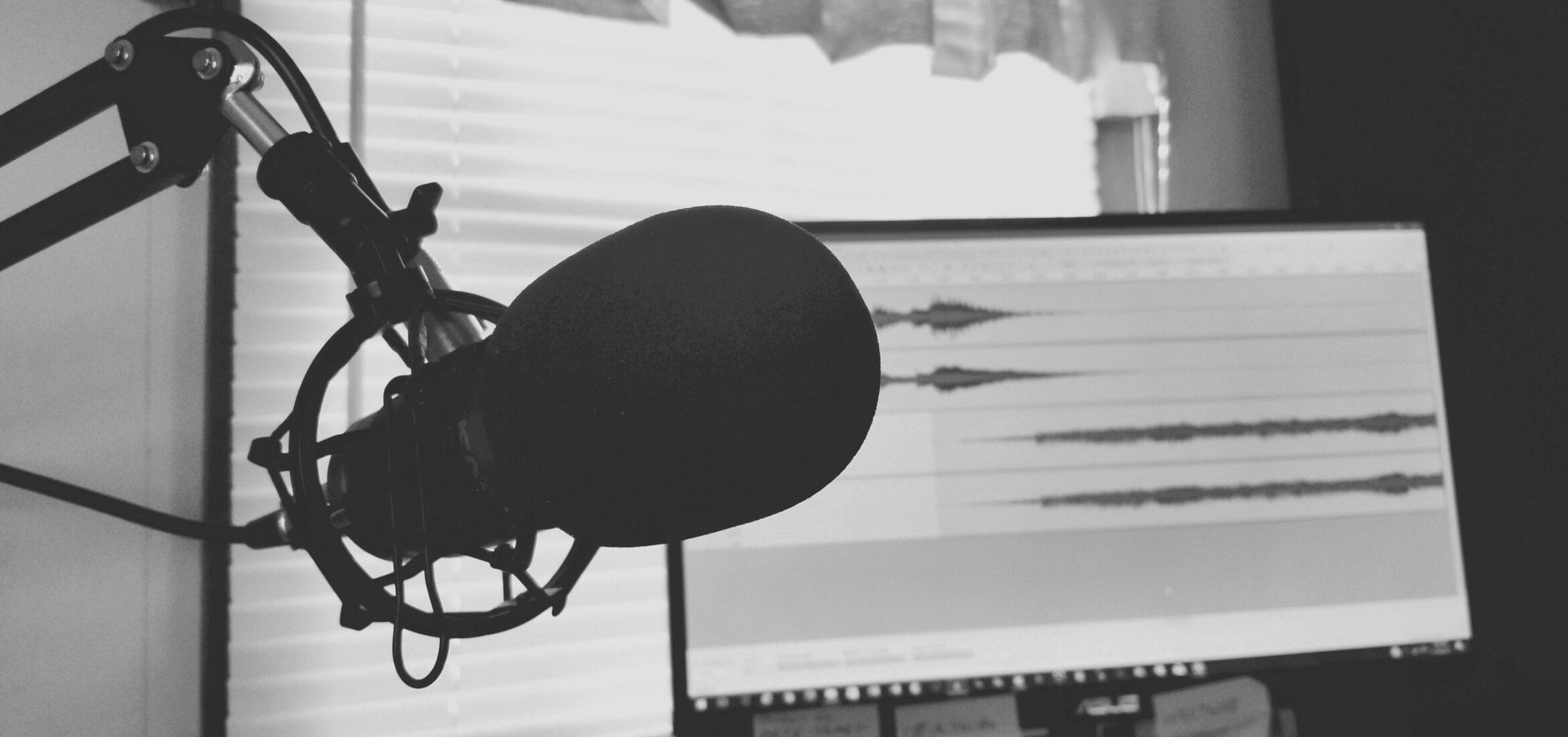If you’ve ever started learning how to play the acoustic guitar, you’re probably somewhat familiar with chords. You might even be able to play a number of simple and complex chords without a second thought. That said, even if you can play a G major, D minor, or E7 chord, you might not understand exactly what’s going on each time you lay down your fingers and strum. And frankly, you don’t have to understand. As long as you know what sounds right and can determine how to play a given chord, you can learn just about any song out there. However, having some rudimentary chord knowledge can greatly elevate your playing, songwriting, arranging, and production capabilities. So, while we won’t dig too deeply into scales and chord theory here, we’ll lay out the basics of different chord types.
What are Chords?

A chord is simply a set of three or more notes played at the same time. For instance, the G major chord that most guitarists learn early on contains the notes G, B, and D. When these are played concurrently, they’re called a G major chord; when each note is played separately, this sequence is known as a broken chord, or “arpeggio.”
Chords derive their specific names and categories from the relationship between their notes. For instance, the G major chord is named as such because the note G is its root, and the notes B and D occur in its major scale at the 3rd and 5th position. This common chord also falls under the category of “triad” (“tri-” meaning “three”) because it is made up of three notes. All triads are chords, but not all chords are triads. A chord may contain four notes, five notes, or more. However, if only two notes occur simultaneously, this is typically known as a partial chord.
The Most Common Chord Types
If a chord is just a collection of three or more notes played at once, the math would suggest that there are thousands upon thousands of possible chords out there. While the jury is out on the exact number of chord formations, there’s no denying its sheer magnitude (could be in the millions). But if this is the case, then why do so many songs contain the same chords (or at least the same types of chords)?
The short answer: they sound good. Sure, you could come up with a chord containing every note in a given scale (just rest your arm on a piano), but it will likely disturb your eardrums and scare your pets. Plus, you’ll have a hard time naming that chord in technical terms (just call it “ugly“).
We like hearing these common chords because the frequencies of their notes relate to one another through melodies and harmonies. It’s the same reason we enjoy looking at contrasting colors and tasting complementary flavors. When the components work well together, they create something beyond the sum of their parts. Practically speaking, you only need to know about a handful of chord types to get a grip on the vast majority of music out there (whew!). Each of these chord types contains several possibilities depending on the root note and key, of course. For instance, G major, A major, and C major are all major chords, but each one contains different notes. Let’s go over five of the most common chord types, what they signify, and why they’re so prominent.
Major Chords
As mentioned earlier, major chords contain the 1st, 3rd, and 5th notes of a major scale. A C major chord, for instance, contains a C, E, and a G. These chords sound happy, triumphant, and uplifting, and are hands-down the most commonly used chord in popular music.
Minor Chords
Minor chords are closely related to major chords, and just about as commonly used. They contain the 1st, 3rd, and 5th notes of a minor scale. So, a C minor chord would contain a C, E flat, and G. Minor chords sound sad, bittersweet, and crestfallen.
7th Chords
The “7” in 7th chords refers to the 7th note played in a scale. This note is tacked on to a standard major or minor chord. So, a G7 major chord consists of G, B, D, and F. 7th chords, whether major or minor, sound unresolved and locomotive, making them useful for bridges, pre-choruses, or transitions in general.

Diminished
A diminished chord takes a minor chord and lowers the top note by a half-step (or semitone). For example, a C minor chord, which contains C, E flat, and G, can become a diminished C chord by leaving the C and E flat alone, but dropping the G to a G flat. This slight change produces an eerie, unsettling, even villainous effect.
Augmented
Conversely, an augmented chord takes a major chord and raises the top note by a half-step or semitone. An augmented G chord, then, consists of G, B, and D sharp. These chords sound inquisitive, uncertain, and suspenseful, like raising an eyebrow.
Other Chord Types
There are, of course, a number of other chord types used here and there, such as suspended and extended chords. These can come in handy, too, especially for genres like jazz and certain brands of R&B/hip-hop. You won’t, however, hear them nearly as often as major, minor, 7th, or even diminished/augmented chords.
Conclusion
Learning about chords is just another way to expand your songwriting and production toolkit. You don’t have to know the names of every note you’re playing or laying out, but understanding the relationships between those notes and how they sound as a result is empowering and invaluable. One of the best ways of developing this relationship is by learning the piano and as you continue to discover more about chord types and their applications, you’ll be surprised at how much you can do with just a couple of chords. And, as always, don’t be afraid to experiment and mess around with unlikely note combinations! You just might find an uncommon chord that suits your song.
About the Author

Ethan Keeley
Writer, Voice Talent, Musician, and Audio EditorEthan Keeley is a musician, voiceover talent, and writer from Rochester, New York. When he's not on tour with his band Unwill he's working on new songs and stories.
Comments
Great help. Thank you!
Leave a comment
Log in to comment



